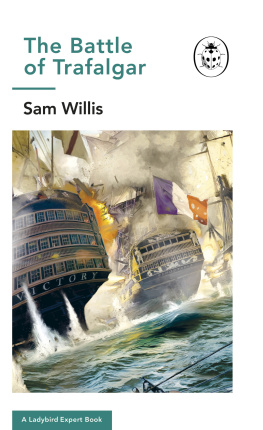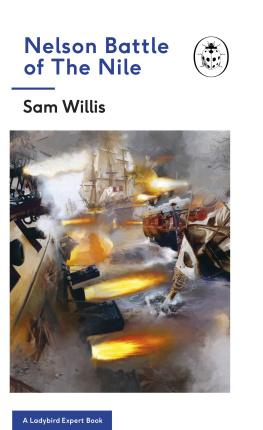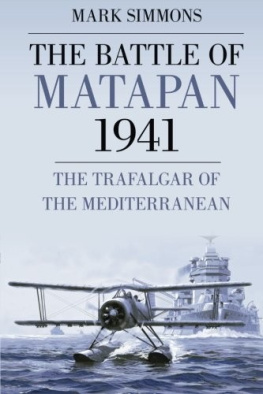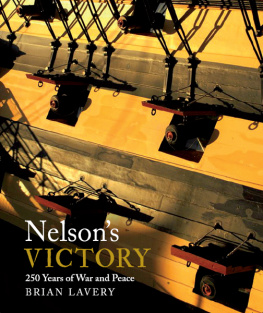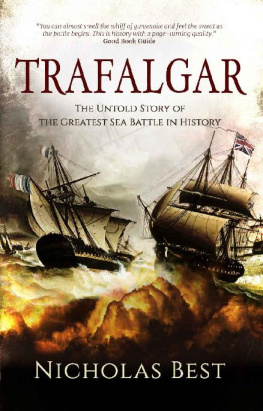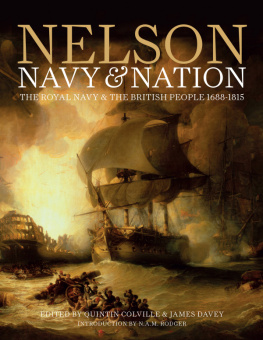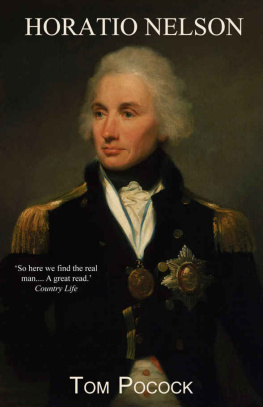A First Rate Taking in Stores, 1818 by Joseph Mallord William Turner, R.A. Trustees, Cecil Higgins Art Gallery, Bedford, England .
Nelsons Undress coat, National Maritime Museum, London, Greenwich Hospital Collection.
Admiral Sir Cloudisley Shovell (16501707) by Michael Dahl, 1702. National Maritime Museum, London .
Admiral John Byng (170457) by Thomas Hudson, 1749. National Maritime Museum, London.
Rear-Admiral Sir John Jervis, Lord St Vincent (17351823) by Sir William Beechey, 178790. National Maritime Museum, London.
Admiral Charles Middleton, Lord Barham (17261813) British School 19th Century. National Maritime Museum, London.
Rear-Admiral Sir Robert Calder (17451815) by Lemuel Francis Abbott, 1797. National Maritime Museum, London, Greenwich Hospital Collection.
Vice-Admiral Sir Thomas Fremantle. National Maritime Museum, London.
Rear-Admiral Sir Alexander John Ball (17571809) by Henry William Pickersgill, 18059. National Maritime Museum, London, Greenwich Hospital Collection.
Sir William Beatty ( c 17701842) by Arthur William Devis, c 1806. National Maritime Museum, London.
Captain Henry Blackwood (17701832) by John Hoppner, 1806. National Maritime Museum, London, Greenwich Hospital Collection.
Sir Thomas Masterman Hardy (17691839) by Domenico Pellegrini, 1809. National Maritime Museum, London.
Rear Admiral Sir Thomas Troubridge ( c 17581807) by Sir William Beechey, 18045. National Maritime Museum, London.
Portrait of Captain Henry W. Bayntun by Sir William Beechey, 1805. Louisiana State University Museum of Art, Anonymous Donors Purchase Fund, 59.8.
The Battle of Trafalgar 21st October 1805 by Joseph Mallord William Turner, 1824. National Maritime Museum, London, Greenwich Hospital Collection.
Portrait of Pierre Charles de Villeneuve (17631806) engraved by Gilles Louis Chrtien. Bibliotheque Nationale, Paris, France . www.bridgeman.co.uk.
Commander-in-Chief of the Real Navy, Federico Gravina (17561806). Anonymous 19th Century. Museo Naval, Madrid.
Commodore Cosme de Churruca. Museo Naval, Madrid. French naval officer Jean-Jacques Etienne Lucas (17641819) c 1800. Getty Images.
Rear-Admiral Sir Horatio Nelson (17581805) by Lemuel Francis Abbott, 1800. National Maritime Museum, London, Greenwich Hospital Collection.
Rear-Admiral Sir Horatio Nelson (17581805) by John Hoppner, c 1800. National Maritime Museum, London.
Vice-Admiral Horatio Nelson (17581805) by Sir William Beechey, 1801. National Maritime Museum, London, Greenwich Hospital Collection.
Horatio Nelson, Viscount Nelson by Guy Head, 17981799. National Portrait Gallery, London.
Horatio Nelson, Viscount Nelson by Sir William Beechey, 1800. National Portrait Gallery, London.
Vice-Admiral Horatio Nelson (17581805) 1st Viscount Nelson by Matthew H Keymer, 1801. National Maritime Museum, London.
Nelson in conflict with a Spanish Launch, July 1797 by Richard Westall. National Maritime Museum, London, Greenwich Hospital Collection.
The Battle of Trafalgar, 21 October 1805: End of the Action by Nicholas Pocock, 1808. National Maritime Museum, London.
The Death of Nelson 1806 by Benjamin West. National Museums Liverpool, The Walker Museum.
The Death of Nelson, 21 October 1805 by Arthur William Devis, 1807. National Maritime Museum, London, Greenwich Hospital Collection.
H.M.S Victory towed into Gibraltar by Clarkson Stanfield, c 1850s. National Maritime Museum, London.
Lord Nelsons funeral, 1806. Courtesy The National Archives.
There is a long tradition of English violence. More Catholics were burned at the stake in 16th-century England than in any other country in Europe. A higher percentage of the population died in the English Civil War than in the French Revolution. The suppression and brutalisation of the Scottish Highlanders after Bonnie Prince Charlies rebellion in 17456 was the scandal of enlightened Europe. All this was part of the nation from which Nelson came. He was able at Trafalgar, as he had been at the Nile and Copenhagen, to summon a scale of aggression from his fleets that seems to have drawn on the deepest levels of common consciousness among his men. This is a difficult area to address, but essential: how does one read into the behaviour of a fighting fleet the deep half-conscious preoccupations of the people who man its ships? How do the semi-understood but widely inherited ideas about purpose, violence and victory, which are present in any evolved society, shape the way men behave in battle? Battle is not simply a question of ideology, military expertise or technology. Deeper and more personal forces are in play and intimate battle, of the kind Nelson invited and created, inevitably engages men at their innermost levels.
By 1805, the sequence of violent and revolutionary events in Europe over the previous fifteen years had established in England or, to be strict, re-summoned a form of millenarian fever which had not been seen since the 17th century. The template for this fever came from the prophets of the Old Testament, from Deuteronomy, Daniel, Ezekiel and Isaiah in particular, and from the Book of Revelation which draws on them. Deep in the Jewish tradition, and radiantly powerful in those books, is the idea that a moment of fearful justice will come, when the wrath of the divine descends on earth. It will know no compromise. Its very violence is a measure of its goodness.
If I whet my glittering sword, and mine hand take hold on judgment; I will render vengeance to mine enemies, and will reward them that hate me. I will make mine arrows drunk with blood, and my sword shall devour flesh; with the blood of the slain and of the captives, from the beginning of revenges upon the enemy. Rejoice, O ye nations, with his people: for he will avenge the blood of his servants, and will render vengeance to his adversaries.
That is the tradition drawn on by the blood-drenched visions of the end of time in Revelation. In this shared vision of the Judaeo-Christian-Islamic world, the moment of utter violence gives way to the moment of utter peace, the tranquillity of the Kingdom of God, the future dream time of the millennium, when all striving is over and all wickedness banished. There will be no peace until the violence is done. Peace is inaccessible without the violence, because violence is righteousness in action. Apocalypse is the route to millennium.



